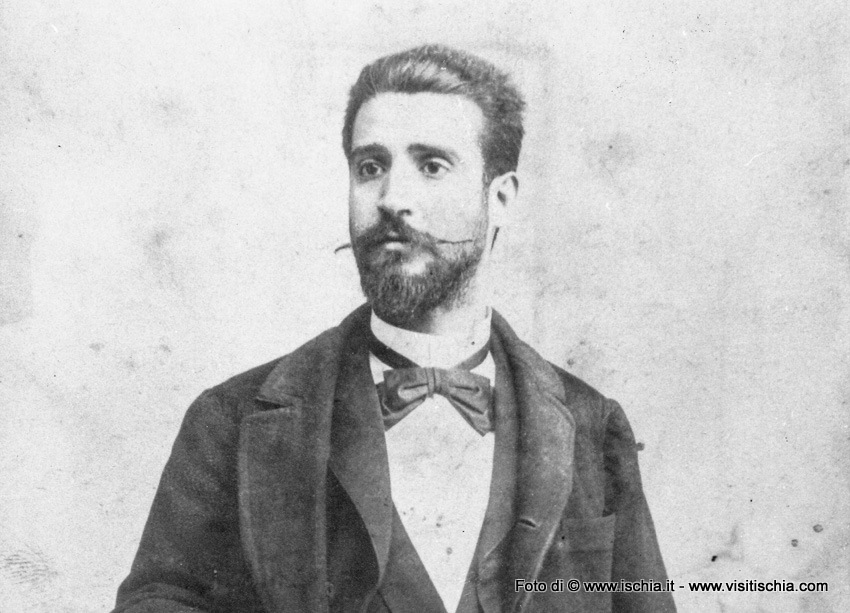Giacinto Lavitrano

Giacinto Lavitrano
The real guarantee of a speech that - despite the travel, the glory and the final decline - steals always, any dramatic event, a matter of score and stage, of nostalgia and regret.
Giacinto Lavitrano was born in Forio in 1875. He is Francesco’ son, uncle of Cardinal Luigi Lavitrano. A comfortable life, to the extent that they can be wealthy existences spent on a small island in the South in the second half of the nineteenth century. The earthquake of 1883 was a crackdown on Lavitrano’s family, as well as a mortal wound to the and the economy of Ischia. The uncles died; his father, a goldsmith, is forced to close up shop and seriously consider the sad fate shared by millions of Italians at that time: to emigrate. Part of the family moved to Algeria, to coastal towns that entertained for a long time business relationship with Southern Italy. In the mid- nineteenth century, part of a line of ships from Sant’Angelo and reaches the shores of the North African country. They are wooden sailing ships as the ‘Cricifisso’, belonging tothe Colella family of Forio, or ‘Luisella’and the ‘Nunziata’. The exodus is continuing. Stora, Bona, Algiers, Philippeville: Algerian ports that receive migrants from the Mediterranean.
Giacinto Lavitrano remains in Forio with one of the brothers, in the birthplace in the center (now the Higher Institute for Tourism "Cristofaro Mennella"). He must complete his studies in harmony and composition at the Conservatory of San Pietro in Majella in Naples to devote himself to music, all-consuming passion that is hard to resist. He specializes in mandolin and other plectrum instruments, wrote his first compositions and became director of a musical band in his country. The co-existence with other ensembles soon turns into mosaic insidious, very difficult to manage. The buoyancy results in litigation, the old resistors irreconcilable disagreements. Lavitrano comes into collision with another director of the place: The Fort. They are neighbors, could not find a form of civil armistice. The conflict is perhaps the most profound. About his land, his roots, a world that must be tight and not allow him to express himself as he would like. Thought should therefore be to Algeria, the family now distant, almost a bridge of light on his confused state of mind. The oral tradition, fond of certain theatricality, wants one day, on the forecourt of Salvation, consumed with anger and bitterness, has made the decision to start throwing a large stone in the sea and vowing never to return. The die is cast.
He reach his family members to Bona (now Annaba) , Algeria, where his brother, meanwhile, opened a tailor shop. The Lavitrano family is a landmark in the community in 1900 when Vittorio Emanuele III was king of Italy, it is Giacinto to send a telegram to the Savoy devotion on behalf of the Italians in the city. The qualities of musician are immediately recognized and appreciated. He became organist of the Cathedral of St. Augustine, hada band of his own, he devoted himself to compositions for guitar pick, not to mention those for organ and piano. Numerous publications on Italian and foreign music magazines (“L’Estudiantina”, “Il Concerto”). Lavitrano, whose name is naturalized in French ‘Hyacinthe’, is in the most fruitful time of his life and career. Frequent trips to Europe - there are traces of his passage to Spain and northern Italy - deep friendships with composers of his time, among them Camille Saint-Saëns, who often goes to visit him in Algeria, interventions in fervent on intellectual debate the role of music and compositional innovations. The French musical impressionism dictates the rules. It’s the time of Debussy, Satie, Ravel, Delius. The shape becomes free, the feelings of the musician fugitive dream, evanescent. With a touch of inevitable exoticism. Many awards to his art, not least that of the Institut de Academie Populaire in France.
The final part of the life of Giacinto Lavitrano, as often happens to artists, is marked by economic hardship and melancholy. He had never married, and family members were all immigrants in France. Daniel Matrone, one of his descendants, is now a performer of international renown. We do not know if he ever came back in Forio, even if only for a few days, breaking the oath made many years before. What we know is that for many years he sent to the parish of San Sebastian in Forio a piece of music for organ, choir and soloists. Seven compositions that would be part of a larger work, the “Desolata”, inspired by the image of Our Lady of Sorrows in which the musician had been devoted. Copies of those scores were transcribed by Maestro Cav. Giuseppe Colella and today played by Maestro Giuseppe Iacono all over the world from Los Angeles to Buenos Aires. To confirm that an international reputation in Japan is the most enthusiastic consent. "La desolata" is now performed in the churches of Forio during the Passion Week. Re-proposing the creations is more than just a tribute to his memory and his music. Without taking for granted the grandeur, or on the contrary, looking at it with enough, but finding good reasons to rediscover the original voice of a narrator of his time. Beyond the commemorations of the ritual, or the more or less authentic gratitude towards a child of their own land.










